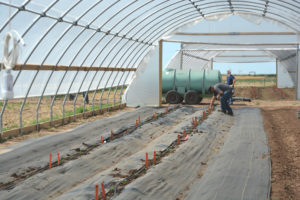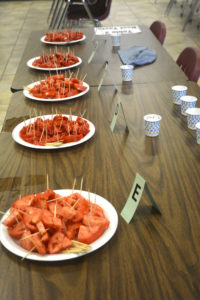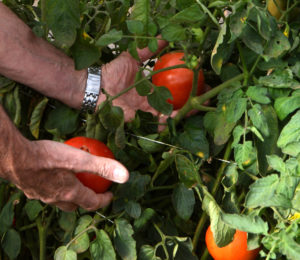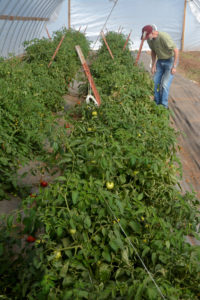
Contact: Dr. Charlie Rush, 806-354-5804, crush@ag.tamu.edu
AMARILLO – Dr. Charlie Rush is claiming success – tomatoes from a Texas A&M AgriLife Research high tunnel project are being sold in an Amarillo grocery store.

Texas A&M AgriLife-grown tomatoes were offered for sale in United Supermarkets in Amarillo. (Texas A&M AgriLife photo by Dr. Charlie Rush)
And now the real work begins.
“We delivered tomatoes to United Supermarket in Amarillo, and they were thrilled to get them,” Rush said. “The next day we delivered jalapenos and poblano peppers. We can produce a quality product and there is clearly a market for the produce.
“Now, we need to work on maximizing yields, cropping systems and pest management, provide an economic analysis and convince a few growers to give it a go.”
Rush, an AgriLife Research plant pathologist in Amarillo, said the project is funded by the U.S. Department of Agriculture Ogallala Research Initiative and the Texas Department of Agriculture Specialty Crop Block Grant Program. The project’s goal is to provide locally grown tomatoes and other high-quality vegetables to the public.
This year’s crop, which suffered setbacks in its inaugural season, has produced about 1,500 pounds of tomatoes, of which almost 500 pounds were marketed through United, along with almost 500 pounds of jalapeno and poblano peppers, he said.
https://www.youtube.com/watch?v=-xOa-mOrqMs&feature=youtu.be
Rush started construction of four high tunnels in April. Dr. Kevin Crosby, an AgriLife Research tomato breeder in College Station, and a breeder with a private company in California each identified the best varieties for the project and provided seed for the study.
Those seeds were planted in a greenhouse first, then transplanted in early May. Drip tape was installed to water the 20 plants of each line in each of the four tunnels.
The trial provided learning opportunities, Rush said. Rabbits ate early crops so fencing was installed. There were initial difficulties getting water and electricity to the high tunnels. Extreme heat in the high tunnels caused a number of the newly planted seedlings to die, and the entire study was replanted May 16. That was followed by a high incidence of tomato spotted wilt in the transplants, so the entire study was replanted again on June 30.

Newly planted tomatoes in the Texas A&M AgriLife high tunnels near Bushland. (Texas A&M AgriLife photo by Kay Ledbetter)
Rush said a typical high tunnel has six rows in cultivation, but only two rows were planted this year in two different high tunnels. An exact replica of the high tunnel experimental design was planted in a field adjacent to the tunnels for comparison.
The first tomatoes were harvested on Sept. 27 and the fruit was picked weekly, divided into marketable and unmarketable, and weighed, he said. Then it was sent to the Vegetable and Fruit Improvement Center at Texas A&M University in College Station for quality analysis.
Tomatoes purchased from local retail grocers were included in the quality analysis as comparative commercial controls, Rush said. The tomatoes from all four cultivars raised in the high tunnel plots were evaluated in a blind test for taste and appearance.
Tomato yields have been higher in the high tunnel plots than in the field, he said. Of the four cultivars, the three from the Texas A&M program have significantly out-yielded the commercial entry from California, possibly because the Texas A&M entries were developed for Texas growing conditions and the California entry was not.
In the taste and appearance test, the Texas A&M cultivars grouped together in the results and all were judged to taste significantly better than either the California entry or commercial control, which also grouped together statistically in the rankings, Rush said.

Taste test participants were asked to rank five varieties of tomatoes, four of which were grown in the Texas A&M AgriLife Research high tunnels. (Texas A&M AgriLife photo by Kay Ledbetter)
He said the testing allowed participants to rank the five entries first on looks, then on taste, as well as do another taste comparison between tomatoes grown inside and outside.
“The taste test is really what it is all about, because it gets down to the consumer and what they like and what they don’t like,” Rush said.
The California entry also was significantly different in quality parameters measured at the Vegetable and Fruit Improvement Center from the Texas A&M cultivars, but it was the same as the “grocery store” controls, Rush said. This could be because there is a high likelihood that tomatoes obtained as a control from the grocery store came from California.
He said tomato plants growing inside the protected area produced about 25 percent more than plants growing in outside plots, and quality inside the tunnels was as good or better than those grown outside.
“That means you can get more tomatoes inside the high tunnels and get just as high quality of a product as trying to grow a tomato outside,” Rush said. “Often you hear that greenhouse-grown tomatoes are not very good. And certainly tomatoes that are shipped from hundreds if not thousands of miles away and end up in the grocery store are often not very tasty, especially when they have to be picked green and shipped so far.

Tomatoes growing in high tunnels. (Texas A&M AgriLife photo by Kay Ledbetter)
“We demonstrated this year that it is possible to produce good yields of very high-quality, locally grown vegetables and market them to local retailers,” he said.
United Grocery Markets began collaborating with Rush in the middle of the project, stating they were looking for a steady and constant supply of high quality, locally grown produce. The first AgriLife Research-produced tomatoes from the high tunnels were delivered to their store Oct. 27, and peppers grown in the high tunnels followed a couple days later.
“In the coming months, we will complete analyzing and graphing of the data from this project,” Rush said. “We will compare how the tomato varieties differed in the incidence and abundance of major pests and beneficial insects.
“We will also quantify seasonal pest pressure, which will be useful in providing recommendations for planting time and pest scouting efforts in the High Plains,” he said. “Quality and yield data will be analyzed to compare the cultivars used in this study and high tunnel and field production.”
Another aspect Rush is monitoring is water savings.

Dr. Charlie Rush, Texas A&M AgriLife Research plant pathologist in Amarillo, looks over tomato plants growing in high tunnels. (Texas A&M AgriLife photo by Kay Ledbetter)
“Tomatoes are fairly water intensive in their requirements, but you are able to get so many more tomatoes in such a small area compared to an acre of corn, so way more income with a lot less overall water.”
Rush estimated, based on limited production the first year, that a high tunnel with six rows, about 240 plants, could produce almost 2,300 pounds of tomatoes. These could be sold for $1 to $3 per pound, depending if they were sold to a retail grocery store or at a farmers market.
“To get that yield this year, we applied 38,000 gallons of water,” he said. “Although that sounds like a lot of water, is isn’t much when compared to what is required to grow a corn crop. For instance, the average yield of corn is approximately 175 bushels per acre and it takes about 21 acre inches or about 570,000 gallons of water to grow it.
“At today’s market price of around $3.50 per bushel, that means a farmer would gross a little over $600 for an acre of corn, and he would need 21 acre inches of water to do that. At just $1 a pound, growing tomatoes in just one high tunnel could gross $2,300 for only 1.4 acre inches of water.”
Rush said he thinks he can increase tomato yields and use less water than he did this year, but he also acknowledges that labor costs for production of high-value vegetable crops will be much higher.
He has recruited Dr. Bridget Guerrero, an agricultural economist from West Texas A&M University, to conduct an economic analysis of high tunnel vegetable production.
“Her analysis is the type of information required by farmers to determine whether they are willing to try this new venture,” Rush said. “It won’t be for everyone, but because of the declining water table in the Ogallala Aquifer, small farmers and those with limited irrigation capabilities may consider giving high-value vegetable production a try.
“We are convinced this research will reveal a number of new business opportunities for agriculture in the Texas Panhandle,” he said. “We are very excited about its potential for the future. We are saving water, producing a commodity that people like and that is locally grown, so it looks like it is a win-win for everybody.”












